The PhidgetSBC3 is a Single Board Computer with an integrated PhidgetInterfaceKit 8/8/8. At its most basic, it can be thought of as a Phidget that you connect using a network cable instead of USB. The PhidgetSBC3 also provides six high-speed ports that allow you to use normal USB Phidgets over its network connection. This can extend the effective range of a Phidget from USB’s maximum of 15 feet, to anywhere that your network reaches.
The PhidgetSBC3 exposes an easy to use interface for setting up and running custom applications on-board. This allows the PhidgetSBC3 to operate autonomously, without the need for a graphical interface or a remote connection at all times.
For more advanced users, the PhidgetSBC is an embedded computer that runs Debian GNU/Linux. We provide full shell access via a built-in SSH server, access to the full Debian package repository, and all of the standard command line tools expected on a modern Linux system.
An integrated PhidgetInterfaceKit 8/8/8 allows you to connect devices to any of 8 analog inputs, 8 digital inputs and 8 digital outputs. It provides a generic, convenient way to interface your PC and PhidgetSBC with a wide variety of devices and it operates exactly the same way as an external PhidgetInterfaceKit.
Support for C, C++, Java, .NET(Mono), or Python can be added from the Debian package repository, as outlined in the user guide.
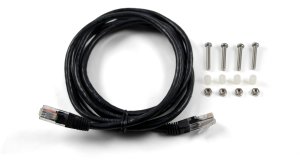
This Phidget requires a power supply between 6 and 15V DC. Select the power supply from the list below that matches your region's wall socket type.
| Product | Electrical Properties | ||
|---|---|---|---|
| Part Number | Price | Power Supply Current | Output Voltage |
 Power Supply 12VDC 0.5A - EU
|
$1.50 | 500 mA | 12 V |
 Power Supply 12VDC 0.5A - US
|
$1.50 | 500 mA | 12 V |
 Power Supply 12VDC 2.0A - AU
|
$10.00 | 2 A | 12 V |
 Power Supply 12VDC 2.0A - EU
|
$10.00 | 2 A | 12 V |
 Power Supply 12VDC 2.0A - UK
|
$10.00 | 2 A | 12 V |
 Power Supply 12VDC 5A
|
$20.00 | 5 A | 12 V |
 Power Supply-12VDC 2.0A - US
|
$10.00 | 2 A | 12 V |
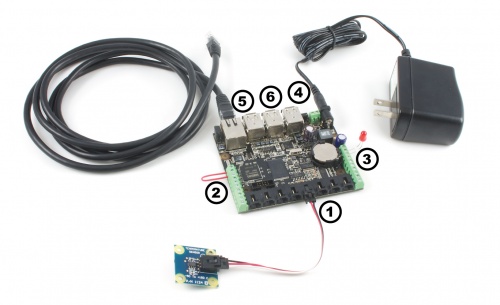
Make sure you have the latest version of the Phidget Drivers installed on your PC. If you don't, follow these steps:
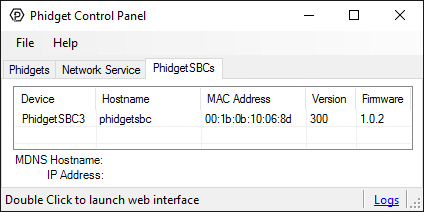
Double clicking on the ![]() icon will start the Phidget Control Panel, which acts as an easy example launcher and will automatically detect any Phidgets plugged in to your computer. We'll use the Control Panel to ensure that the new Phidget works properly.
icon will start the Phidget Control Panel, which acts as an easy example launcher and will automatically detect any Phidgets plugged in to your computer. We'll use the Control Panel to ensure that the new Phidget works properly.
After double clicking on the icon, a window will open with a list of all attached Phidgets. Click on the PhidgetSBC tab, and you should see a list of PhidgetSBCs connected to your network. Double click on an SBC to bring up the configuration page in your default web browser. You can differentiate multiple SBCs by their MAC address, which is printed on a sticker on the underside of the board.
This control panel view will tell you (at the bottom):
You will need one of these two pieces of information when you start working directly with the SBC Operating System for tasks such as writing and running code on the SBC, so write these down somewhere while you work through the rest of this page.
Basic use of the PhidgetSBC allows the opening of connected Phidgets over the network. Using another Phidget with the PhidgetSBC in this way is almost exactly like using Phidgets over USB, in respect to the API calls and behavior. However, some extra considerations need to be made when working with the Phidget Network service.
Support for opening Phidgets over the network is made possible via the Phidget Network service. This allows a user to write an application in a system and language of their choosing and then operate Phidgets connected to the PhidgetSBC. It is a socket based server that runs on the PhidgetSBC, and allows any attached Phidgets to be seen and opened directly over the network. To use this server go to the "Phidgets->Network Service" tab in the web configuration page and enable it.
Opening and controlling a Phidget over the network is nearly the same as opening one locally. The main differences are:
Opening a Phidget over the network is asynchronous and pervasive, just like opening locally. This means that if a connection to the remote server cannot be established right away, it will keep trying indefinitely, and even survive the server being stopped and started, etc. Instances of the Phidget Network service can be referred to either using hostname (IP Address) and port number, or by Server ID. The advantage of using a Server ID is that it stays consistent compared to IP addresses, and you don’t need to know the Port number. A Network service Server ID is assigned when the Network service is run - which on the PhidgetSBC defaults to ‘phidgetsbc’. In order to use a Server ID, the Bonjour utility also needs to be installed. Refer to the Programming Manual and the API manual for your language for more information about using the Phidget Network service.
Determining reliability needs can become important while opening Phidgets over the network, because the network connection can potentially be interrupted at any time. This can leave the network attached Phidget in an undesirable state. For example - if a motor controller is driving a motor and the connection is lost, there is no way to stop the motor until the connection is re-established. These issues are less important if you are just receiving sensor data from an Interface Kit.
It’s generally a good idea to catch server connect and disconnect and Phidget attach and detach events in order to know the state of the connections. It’s also a good idea to catch error events - this is where network errors will be reported. If reliability is important, you should consider writing a program to run locally on the PhidgetSBC, and communicate with it through the Dictionary interface. This way, if the connection is broken, the local application will notice and be able to take any appropriate actions. See the advanced chapter for more information.
Any Phidgets attached to the PhidgetSBC can be identified using the Status >> Phidgets page in the configuration interface, and should be seen on the network through the Network service. The Phidget Control Panel has a Bonjour tab (under Network Service >> Bonjour) that lists all detected network attached Phidgets. The Phidgets connected to the PhidgetSBC should be seen here and can be opened by double clicking its name in the menu. Network attached Phidgets can also be located programmatically with the Phidget Manager. The Phidget Manager is used with either hostname and port, or server ID, just like with ‘Open’. The manager can also be used to find all Phidgets on any Network service through Bonjour, by specifying a NULL Server ID. See your specific language’s guide for more information about coding with the Phidget Manager.
The steps are very similar to the Windows process described above:
The address in the browser that connects to the SBC is either an IP address (such as 192.168.2.181) or a link local address, (such as phidgetsbc.local, which is the default). Note down the address in the browser, as you will need this information for later if you will be working directly with the SBC to perform tasks such as writing or running code. But for now, with the web interface open, we have a section to walk you through it.
With Linux, you have many setup options, but all involve knowing the IP address or link local address of the SBC after you have plugged it in as described in introductory video. The IP address can be somewhat difficult to obtain, but the default link local address for all new Phidget SBCs is phidgetsbc.local - which is an mDNS address. Wait at least three minutes after booting the SBC to make sure link local addressing is started. You'll also need some form of mDNS (either avahi or mDNSResponder) installed on your main computer. The avahi service is usually installed by default on most Linux machines, try which avahi-resolve to make sure. Then, try typing phidgetsbc.local into a web browser. The web interface should come up, starting with the Set the Password screen.
Note that some browsers (i.e. Google Chrome) combine search and addressing in the same address bar, so you may need to turn off Network service and prediction service in Preferences → Under The Bonnet for Chrome to treat phidgetsbc.local like a web address rather than a search term. If these steps do not bring you to the initial setup password screen as shown in the SBC Web Interface section, you will probably need to read the internet setup section on the SBC OS Page. That section contains more than just troubleshooting information - it includes in-depth information on how the SBC starts its network, your initial network configuration options, and how to connect to the SBC without mDNS using both DHCP and static IP.
If you want to use the SBC to broadcast data from Phidgets over a network, the SBC is already automatically performing this function with its attached Interface Kit, and will also do so for any Phidgets plugged into its USB ports. If this is your sole intended use of the SBC, you can skip ahead to our example on using the attached Interface Kit.
However, the SBC is much, much more than simply a way to get data from Phidgets over a network. You can use the SBC as an external Linux computer. You'll need to set a password using the SBC web interface, and write down a network address of the SBC (phidgetsbc.local, or an IP address if you worked through the internet setup section on the SBC OS Page). But after that, if no other sections in the basic SBC web interface section apply to you (using the webcam, setting up wireless networking, or checking system parameters like memory), you can skip ahead to the OS - Phidget SBC page.
As soon as the SBC boots and can connect to the network (either by DHCP or by mDNS/avahi), it begins broadcasting the state of its attached InterfaceKit over the network using the Phidget Network Server. To test the InterfaceKit on your Linux computer over the network, you will need to install the Phidget libraries and the Phidget Network Server if you haven't already. (If you have used any Phidget via USB and over a network on your Linux computer, you have already done this.) This process is described on the general Linux OS page, so follow those installation instructions, with the following modifications to the Linux Network Server introduction:
phidgetsbc) address,openRemoteIP in your code, use the function call openRemote, and the Interface Kit serial number which is on the back of the SBC.Note that any attached analog sensors in the black ports will not show up over the Network Server as individual Phidgets. Rather, they will show up as part of the Interface Kit, through the port number that they are attached to on the SBC board.
Using the operating system sections of this guide, you should have been able to open a web browser with a connection to the SBC using either:
Here we cover the basics on the tool that has been opened in the browser, known as the SBC Web Interface.
If this is your first time connecting to the SBC (or after a complete factory reset), you will see a screen asking you to set a password:
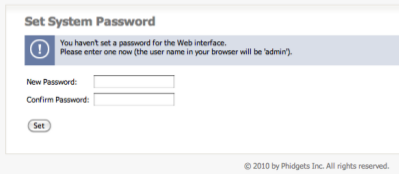
This password will be linked to the user admin if you use the web interface in the future, and to the user root if you choose to use SSH. These are actually the same user, and the SSH connection is covered in-depth on the SBC operating system page.
Remember this password, as you will need it to connect to the SBC in the future, and the only way to log in if you lose it is to perform a full factory reset on the SBC.
The next time you connect to the SBC after you log out or reboot the SBC, you will be asked to log in with a user name and password:
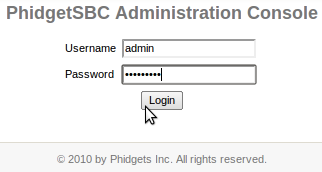
The SBC Web Interface has a series of tabs and sub-tabs at the top, and by using these you can access the entire web interface. Note that the web interface only allows you to configure a very small portion of the SBC, please refer to the full OS - Phidget SBC page for an in-depth introduction on the SBC Linux operating system.
The header also has information about how long the SBC had been powered on without a reboot, what the link local address of the SBC is (here it is phidgetsbc, so the full link local address is phidgetsbc.local) and more:

The starting page of the web interface will also give you information about:
System → General, although note that this will also change the link local address of the SBC to that name)Network → Status when the adapter is plugged in)This can also be accessed later from Status → System:
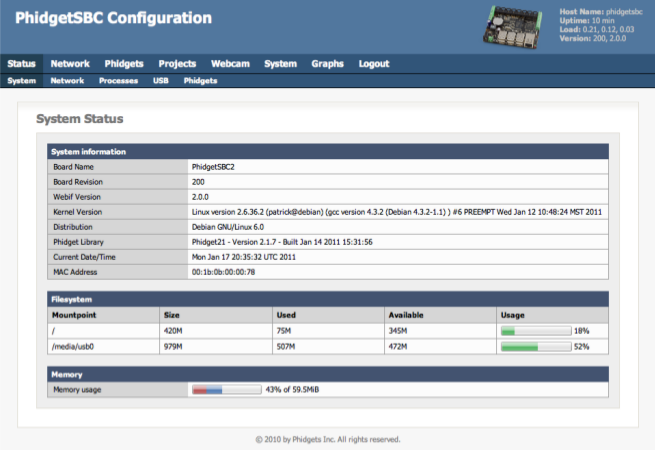
After using the initial wired Ethernet connection (as described in detail in the hardware section) to access the web interface for the first time, you can use the Network tab in the web interface to configure other network settings for use.
The SBC can switch dynamically between Ethernet (what it tries first) and wireless via the Wi-Fi USB Adapter w/SMA Antenna. It is also able to dynamically handle both Ethernet and wireless being unplugged and then plugged back in. This is especially useful if you are designing a project where the SBC will operate without a network - when testing you can plug in and remove the network adapters to check on how the SBC is doing.
The SBC can only access wireless networks using the Wi-Fi USB Adapter w/SMA Antenna. If this WiFi adapter is plugged in to a USB port on the SBC, you will see something like this under Network → Wireless in the web interface:
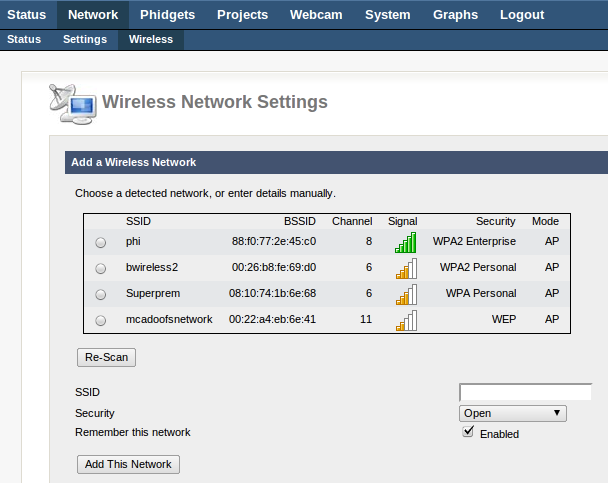
Here you can add and remember networks with passwords. These do not necessarily have to be networks that are currently seen - you can add the SSID and password of your home network, for example, and the next time the SBC boots at home with wireless only it will connect to your home wireless network. These SSID settings are only for DHCP networks.
If you do not have DHCP on your main network, and do not want to use link local addressing, you can set the network connection to be static. These settings can be found in the web interface under Network → Settings for the Ethernet interface, and at the bottom of Network → Wireless for wireless networking. In the Ethernet settings, for example, you can specify network elements manually in the same way you would for a desktop computer:
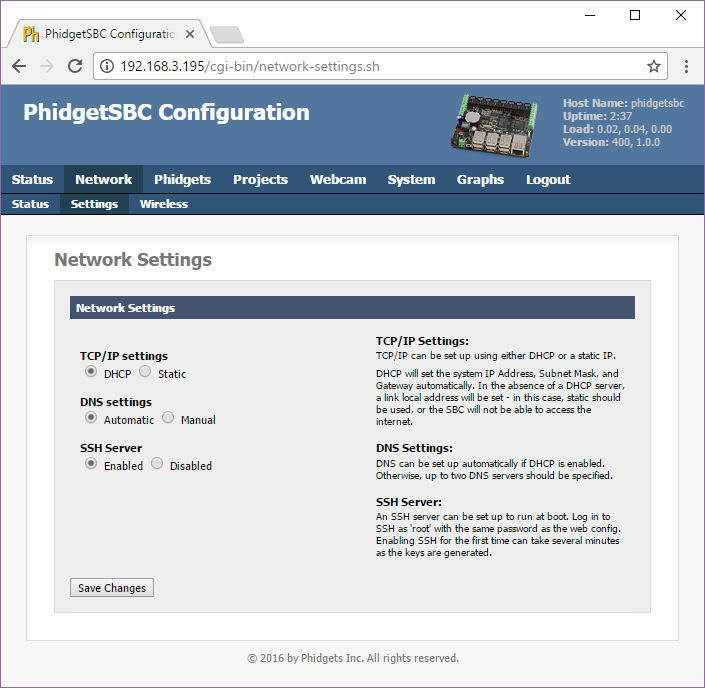
This setting is also useful to work entirely without mDNS and link local addressing. After setting it, the SBC will start using that static IP immediately, so if this is done improperly this can make the SBC very hard to re-connect to depending on the routing within the rest of your network. If you are not sure whether this will be a problem, it may help to read the in-depth network troubleshooting section for the SBC.
You can view Phidgets that are directly attached to the SBC by going to Phidgets → Status in the web interface:
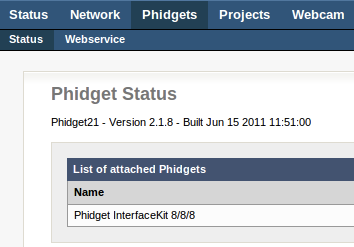
This will always show the attached Interface Kit that is part of the SBC board. It will also show any Phidgets plugged into the SBC's USB ports.
On the right hand side of this screen (not shown in the screenshot) you will see the serial numbers of the attached Phidgets. If you want to use these Phidgets within your code over a network using the network server, you can use these serial numbers in your programming project.
Note that any analog or digital sensors will not show up here, as they are a 'part' of the Interface Kit and can be accessed through the ports in the Interface Kit API. Taking a look at the User Guide for the PhidgetInterfaceKit 8/8/8 will show you a good example of how this works.
Using the webcam (either the Phidget USB Webcam or another UVC-compatible webcam) should be fairly straightforward. Plug it in, then head to the web interface under Webcam → Webcam:
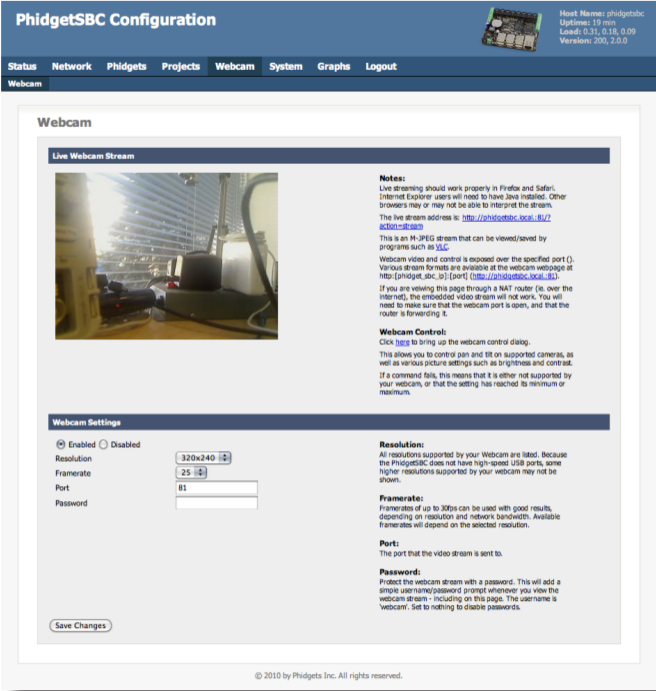
This will allow you to stream video into the web interface. This stream can also be viewed with any compatible M-JPG viewer, such as VLC. To take pictures with the webcam within your code, see the how-to on the main SBC operating system page.
Webcams that support pan/tilt can be controlled via the web interface. Multiple frame rates and resolutions are supported.
If the video stream is to be exported over the internet, it is recommended that the password be enabled. However, it must be noted that this is a simple HTTP authentication, which is sent unencrypted, and is thus not highly secure.
If prompted for the webcam password, the username is ‘webcam’.
If multiple webcams are attached, they will all start up using the same settings, except that each additional webcam will run on the next higher port number. Multiple webcams will generally only work when the resolution and framerate are set to low levels.
At this point, we have covered most of the common uses of the web interface. But the web interface offers many more configuration options. This reference section covers all of the available options. If you want to continue on to tasks such as writing and running code on the SBC, visit the OS - Phidget SBC page.
Probably... In theory you can connect multiple webcams to the SBC, however, the bandwidth of a USB1.1 hub will limit the amount of data you can stream meaning you might have to use reduces resolution/framerate to do it successfully.
This section provides a complete reference to all tabs and sub-tabs within the SBC web interface. Note that the web interface itself also includes help as text on the right side of most tab screens.
On loading the interface, you will see a tool bar along the top of the page. It holds some information across all the configuration pages. The information is as follows:
The main tab Status has options for System, Network, Processes, USB, and Phidgets.
This is the first page you should see after loading the configuration Interface. It contains general information about the SBC.
See: Tab: Network
This lists all running processes, along with their Process ID (PID), User, State, CPU usage and memory usage. Advanced users can use this to tell if any application is using too much memory, or has crashed.
This lists all USB devices. The “S3C24XX OHCI” Host Controller, the “General Purpose USB Hub” and the built in Interface Kit 8/8/8 should always be listed, along with any connected devices. Also listed are any mounted USB drives.
See: Tab: Phidgets
The main tab Network has the sub-tabs Status, Settings, and Wireless.
General network status can be viewed on this page. Modifying these values are done on other pages.
This is where TCP/IP settings for the wired ethernet and configured. This is also where SSH is enabled.
Wireless networking is supported via a USB wifi adapter. When an adapter is plugged in, this wireless configuration page will be available.
Wireless networks are joined based on a list of saved networks. You can join, manually enable and disable, as well as delete these saved networks. To add a wireless network to this list, either choose from the list of detected networks, or enter the details manually. Supported security includes WEP, WPA(2) Personal and WPA(2) Enterprise.
Saved networks will be joined first based on security and secondly based on best signal strength.
The Phidget network server is a simple server that allows Phidgets connected to the PhidgetSBC board to be opened over the network. This is enabled by default and starts with the SBC.
This page lets you view and modify the Phidget network server settings, as well as stop and start the server. Please see the Advanced User’s Guide for more information on programming with the dictionary.
This is where user projects are set up. Custom applications can be written in either C (compiled to an ARM architecture) or Java, and then set up to run on the PhidgetSBC at system startup. We offer an in-depth tutorial on creating applications in this manner using Java.
This sub-tab lists installed applications as well as the controls for creating a new application space.
This is also where you can download the SBC-specific version of the Phidget Java libraries: phidget21.jar
This is a list of all created applications and their current status. Enabled applications will try to run on system boot, and the stopped/running status indicates if the program is currently executing.
Delete applications using the red ‘X’ near their name. You can click on the application name to launch the Specific Project page.
On a specific application space page, there are controls to start and stop the program, as well as view the stdout and stderr from the most recent (or current) run.
This allows viewing, editing and removal of application files, as well as the ability to upload new files. File upload size is limited to 5MiB per file.
This section configures the application to start at boot. When this enabled, it will start at the end of the system boot process (after things like bringing up the network, starting the Phidget Network Server, etc.). The startup order field specifies a start order among the custom applications, with lower numbers being started first.
Executable name is the name of the file to execute. If this filename ends in ‘.class’ or ‘.jar’, the program will be run as a Java program, otherwise it is run as an ARM Binary. We have an detailed walkthrough of this section.
This is where general system setting are set up.
phidgetsbc. When used as a link local address, the extension .local is addedThis is where the kernel and system logs can be viewed. This also includes the ability to filter the text. We also have a special section on checking the system logs.
This is where the system password can be changed. The system password is the (which is the admin password for the web interface) is also the root user password on the SBC when using SSH.
Changes here made will take effect immediately after being saved, without asking for confirmation. The new password must consist of alphanumeric characters and be at least 1 character long.
This grants access to the full filesystem. Files can be uploaded, edited and deleted, and directories can be created. Some important system directories and files are protected from deletion, but it is still easy to break the system by editing/deleting files.
File upload is limited to a filesize of 5MiB.
File/Directory permission, owner/group and creation time information is available by hovering over the file/directory icon.
This is where the system can be backed up to disk and restored. This also allows access to the recovery/upgrade system.
Note that this only backs up configuration files directly related to the web interface - such as network configuration, hostname, time settings, and user project setting (but not including project files). For other methods of backup, including installed software, we have a detailed walkthrough.
When restoring from a backup file, the system will check that it is a valid backup before asking the user to continue.
This is where package updates are performed. From time to time, updates will be made available. These will address any bugs and security issues, add new features, and update the phidget21 library and network server. There are also some other package management options available.
Note that this page can take quite a long time to load when 'Include full Debian Package Repository' is enabled.
NOTE: Debian 7 has been archived, so in order to update packages using the repository you need to update the apt file. Go to /etc/apt/sources.list.d/multistrap-debian.list and add the following lines:
# DO NOT EDIT THIS FILE BY HAND -- YOUR CHANGES WILL BE OVERWRITTEN
deb http://archive.debian.org/debian wheezy main contrib non-free
Then, run apt-get update before installing any new packages.
This lists all available package updates, if any.
We also have a detailed walkthrough of installing and using C, Java, and Python on the SBC.
The board can be rebooted remotely from this page. The reboot should take 45-60 seconds depending on network conditions. It tries to shut down all running programs before restarting as opposed to the reset button.
The license information and credits for the configuration interface is displayed here. A link is provided to the original sources and the Phidgets web site.
To reboot the device, quickly press the black reset button found between the USB connectors and the power terminals. Both Ethernet Port LEDs (yellow-connectivity, green-activity), and the green status LED will turn off. The reboot is done when all LEDs come back on in about 25 seconds.
To reset the firmware, press and hold the button for 10 seconds until the green status LED begins to blink, then release. Both Ethernet Port LEDs will turn off (yellow-connectivity, green-activity) for 80 seconds; the green status LED will then turn off; then all LEDs will come back on in 20 seconds. All data will be lost and the operating system will be reset to a factory state.
To boot into the Recovery / Upgrade system, hold the button for 20 seconds until the green status LED switches from blinking slowly to blinking quickly, then release. The recovery system allows for factory reset, full system upgrades and recovery of the main system.
The recovery / upgrade system is a small system from which the main system can be reset/upgraded, or recovered.
The recovery system can be entered in two ways.
Generally, you should not need to do a full system upgrade. Upgrades are meant to be performed via the package system, and Phidgets maintains it’s own package repository from which to push out updates.
Occasionally, you may wish to go back to a clean install and upgrade to the latest rootfs/kernel from Phidgets. Phidgets will not be creating these images with every release of phidget21 as we did with PhidgetSBC1, rather they will be released several times a year, as needed for major changes not easy to push out via packages.
You can also flash your own custom kernel or root filesystem image.
This restores the kernel and root filesystem from backup, overwriting any changes that may have been made. This is equivalent to holding down the reset button for 10 seconds.
If the main filesystem has been damaged/misconfigured in such a way that it won’t boot, you may be able to fix the issue / recovery important files before running a reset. The recovery system runs an SSH server that you can loginto for console access. Username/password is: root/root.
You can mount the main root filesystem with the following commands (assuming it’s not damaged):
|
Numbered in the circles on the diagram:
|
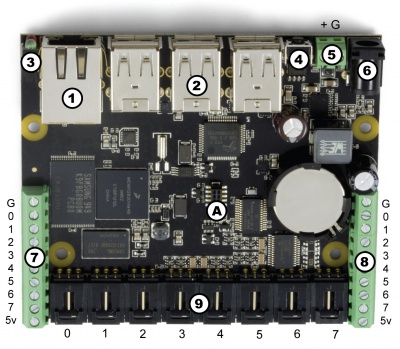
| |

The 12V power supply is stepped down to 5V and distributed in the following way:
Power over Ethernet can be used to provide both a network connection and power to a device when a power outlet is not available. This means that with the proper adapters, you can run the PhidgetSBC entirely off an Ethernet source. The PhidgetSBC does not draw power directly from a powered Ethernet line, but instead can use a setup where the power is split to a separate line again near the PhidgetSBC. The board has been tested and will work with Power Sourcing Equipment that can output 6-12VDC.
The PhidgetSBC is based around the i.MX28 processor. This is an ARM926EJ-S based microprocessor from Freescale, which runs at 454MHz. Connected to this is 128 MiB of DDR2 SDRAM, 1 GiB of very large page NAND and a 10/100baseT Ethernet controller. The microprocessors USB Host port is connected to a 7-port USB 2.0 High Speed Hub chip. The integrated PhidgetInterfaceKit 8/8/8 is connected to one of the hub ports, with the other 6 ports being brought out to the user.
The PhidgetSBC runs Debian/GNU Linux 7.0 as its operating system and gets booted with U-Boot. The kernel is 3.6.3 and generally kept up to date with the latest releases. The root filesystem is created using debootstrap and is mounted in a ~924MiB nand partition using the UBIFS filesystem, in Read-Write mode.
Configuration data is located at ‘/etc/webif’. This is where all configuration that can be set through the website is located.
User applications are stored in ‘/usr/userapps’, each is their own directory.
The kernel is stored on bare Nand in it own 4MiB partition, in the uImage format.
The date and time are set using ntp (network time protocol) at boot. The ntp daemon continues to run in the background and will periodically update the clock, keeping it very close to real time.
There is a real-time clock with battery backup which will preserve date/time across reboots, power removal. The real-time clock is synced to system time during reboot/shutdown. If power is unplugged suddenly, the real-time clock may not have the correct time.
Wireless networking is supported using the available adapter and is configured through the configuration interface.
The configuration system used by the website is stored in ‘/etc/webif’. These files should generally not be changed manually, but there is no reason why they could not be. It’s very easy to enter invalid data that could cause the system to behave unexpectedly or not boot.
The board contains 1GiB of Nand. This nand is split into 8 partitions as follows:
| 0: bootloader | size: 4MiB | Read Only |
| 1: environment | size: 512KiB | Read Only |
| 2: device_tree | size: 512KiB | Read Only |
| 3: recovery_system | size: 4MiB | Read Only |
| 4: recovery_kernel | size: 4MiB | Read Only |
| 5: recovery_fs | size: 83MiB | Read Only |
| 6: kernel | size: 4MiB | Writable |
| 7: rootfs | size: 924MiB | Writable |
U-Boot and recovery kernel and filesystem cannot be written from Linux - this is a safety measure.
This describes the boot process from power on.
The SBC kernel contains driver support for the following USB to Serial Adapters. Please consult the kernel documentation for details into the driver support for the USB to Serial adapters.
| Company | Product |
|---|---|
| ConnectTech | WhiteHEAT |
| Keyspan | USA-18X, USA-28, USA-28X, USA-28XA, USA-28XB, USA-19, USA-19W, USA-19QW, USA-19QI, USA-49W, USA-49WLC |
| FTDI | Single Port Serial Adapter |
| Cypress | M8 CY4601 Family |
| Digi International | AccelePort USB Serial |
| Belkin | USB Serial Adapter F5U103 |
| MCT | USB Single Port Serial Adapter U232 |
| Inside Out Networks | Edgeport Serial Adapter |
| Prolific | PL2303 |
The SBC kernel contains driver support for the following USB Wireless Adapters. Please consult the kernel documentation for more details.
| Company | Module | Chipsets |
|---|---|---|
| Atheros | ath9k_htc | AR9271, AR7010 |
| Atheros | carl9170 | AR9170 |
| Intersil | r8712u | ISL3877, ISL3880, ISL3886, ISL3887, ISL3890 |
| Realtek | r8712u | RTL8188SU, RTL8191SU, RTL8192SU |
| Ralink | rt2500usb | RT2500USB/RT2571 |
| Ralink | rt2800usb | RT2070, RT2770, RT2870, RT3070, RT3071, RT3072, RT3370, RT3572, RT5370, RT5372 |
| Ralink | rt73usb | RT2501USB/RT2571W |
| Realtek | rtl8187 | RTL8187L, RTL8187B |
| Realtek | rtl8192cu | RTL8188CUS, RTL8192CU |
| ZyDAS / Atheros | zd1211rw | ZD1211/ZD1211B, AR5007UG |
U-Boot is used for setting up the processor and booting Linux, and is only accessible by the serial port. Normal users will not need to use it. If you are connected to the serial port, you will see the U-Boot prompt shortly after power up. You can view the environment variables for information on how to properly boot Linux on the PhidgetSBC.
Be very careful when modifying the u-boot partition. If it is damaged or overwritten, it is difficult to fix.
Refer to U-Boot documentation here: www.denix.de/wiki/DULG/Manual for more information on using U-Boot.
The SBC can be configured as a device in an ad-hoc network.
For more information, visit the Ad-Hoc Networks page.
Check the Phidget SBC page for more details about using the Phidget SBC.
Check the 1018 User Guide for more information about the InterfaceKit on this board.
| SBC | |
|---|---|
| CPU | Freescale i.MX28 |
| Core | ARM926EJ-S |
| CPU Speed | 454 MHz |
| NAND Memory Size | 1 GiB |
| SDRAM Size | 128 MiB |
| Boot Time | 30 s |
| Ethernet Cable | 10/100BASE-T |
| Operating System | Debian Linux |
| Board Properties | |
| Supply Voltage Min | 6 V DC |
| Supply Voltage Max | 15 V DC |
| Available External Current | 500 mA |
| Power Jack Hole Diameter | 5.5 mm |
| Power Jack Pin Diameter | 2.1 mm |
| Power Jack Polarity | Center Positive |
| Recommended Wire Size | 16 - 26 AWG |
| Operating Temperature Min | 0 °C |
| Operating Temperature Max | 70 °C |
| Power Consumption Base (w/ Ethernet) | 1.2 W |
| USB Stack | HID |
| Driver Support | Phidget21, Phidget22 |
| Voltage Inputs | |
| Number of Voltage Inputs | 8 |
| Voltage Input Resolution (bits) | 10 bit |
| Input Impedance | 900 kΩ |
| Input Voltage Min | 0 V DC |
| Input Voltage Max | 5 V DC |
| 5V Reference Error Max | 0.5 % |
| Voltage Input Update Rate Min | 1 samples/s |
| Voltage Input Update Rate Max (4 Channels) | 1000 samples/s |
| Voltage Input Update Rate Max (8 Channels) | 500 samples/s |
| Voltage Input Update Rate Max (WebService) | 62.5 samples/s |
| Digital Inputs | |
| Number of Digital Inputs | 8 |
| Pull-up Resistance | 15 kΩ |
| Low Voltage Max (True) | 900 mV DC |
| High Voltage Min (False) | 4.2 V DC |
| Low Voltage Trigger Length Min | 4 ms |
| High Voltage Trigger Length Min | 15 ms |
| Digital Input Voltage Max | ± 15 V DC |
| Digital Input Update Rate | 125 samples/s |
| Digital Outputs | |
| Number of Digital Outputs | 8 |
| Series Resistance | 300 Ω |
| Digital Output Current Max | 16 mA |
| Digital Output Voltage Min | 0 V DC |
| Digital Output Voltage Max | 5 V DC |
| USB Hub | |
| Number of USB Ports | 6 |
| Available Current per USB Port | 500 mA |
| USB Speed | High Speed |
| Customs Information | |
| Canadian HS Export Code | 8471.80.00 |
| American HTS Import Code | 8471.80.40.00 |
| Country of Origin | CN (China) |
| Channel Name | API | Channel |
|---|---|---|
| Voltage Input | VoltageInput | 0 - 7 |
| Voltage Ratio Input | VoltageRatioInput | 0 - 7 |
| Digital Input | DigitalInput | 0 - 7 |
| Digital Output | DigitalOutput | 0 - 7 |
| Product | Voltage Inputs | Digital Inputs | Digital Outputs | Physical Properties | SBC | ||
|---|---|---|---|---|---|---|---|
| Part Number | Price | Number of Voltage Inputs | Number of Digital Inputs | Number of Digital Outputs | Number of VINT Ports | CPU Speed | SDRAM Size |
 PhidgetSBC4
|
$130.00 | 6 (Shared) | 6 (Shared) | 6 (Shared) | — | **Up to 960 MHz | 512 MiB |
| Date | Board Revision | Device Version | Comment |
|---|---|---|---|
| January 2013 | 0 | 300 | Product Release |
| January 2015 | 0 | 301 | Changed flash and updated kernel |
| January 2018 | Product Discontinued. Succeeded by the SBC3003 - PhidgetSBC4. | ||